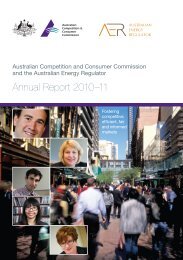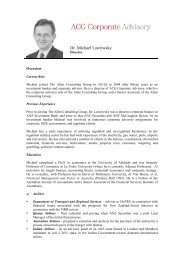Transend - Appendix 5 Renewal capital expenditure - Australian ...
Transend - Appendix 5 Renewal capital expenditure - Australian ...
Transend - Appendix 5 Renewal capital expenditure - Australian ...
You also want an ePaper? Increase the reach of your titles
YUMPU automatically turns print PDFs into web optimized ePapers that Google loves.
0BInvestment Evaluation Summary<br />
TNM-GS-809-0720<br />
The 110 kV bus bar protection scheme at Farrell Substation was found to be generally compliant. However it does not<br />
meet the redundancy requirements specified in clause 5.1.9(d) of the NER.<br />
The replacement and duplication of the 110 kV and 220 kV bus bar protection schemes at Farrell Substation will ensure<br />
that <strong>Transend</strong> complies with the requirements of the NER as identified in Table 2.<br />
Table 2 – Compliance obligations, issues and project objectives<br />
Reference Compliance obligation Substation issue Project objective<br />
NER<br />
Schedule<br />
5.1.9(d)<br />
NER<br />
Schedule<br />
5.1.9(k)<br />
NER<br />
S5.1.2.1(d)<br />
NER<br />
S5.1a.8 (d).<br />
NEMMCO<br />
Operating<br />
Procedure<br />
SO_OP6100<br />
S8.1.3.1<br />
‘If the fault clearance time determined under<br />
clause S5.1.9(e) of a primary protection system<br />
for a two phase to ground short circuit fault is<br />
less than 10 seconds, the primary protection<br />
system must have sufficient redundancy to<br />
ensure that it can clear short circuit faults of any<br />
fault type within the relevant fault clearance time<br />
with any single protection element (including<br />
any communications facility upon which the<br />
protection system depends) out of service.’<br />
‘A primary protection system may clear faults<br />
other than short circuit faults slower than the<br />
relevant fault clearance time, provided that such<br />
faults would be cleared sufficiently promptly to<br />
not adversely impact on power system security<br />
compared with its operation for the<br />
corresponding short circuit fault. ….’<br />
‘The Network Service Provider must ensure that<br />
all protection systems for lines at a voltage above<br />
66 kV, including associated intertripping, are<br />
well maintained so as to be available at all times<br />
other than for short periods (not greater than<br />
eight hours) while the maintenance of a<br />
protection system is being carried out.’<br />
The fault clearance time of a breaker fail<br />
protection system or similar back-up protection<br />
system for a short circuit fault of any fault type<br />
should not exceed the relevant time in column 4<br />
of Table S5.1a.2 for the nominal voltage that<br />
applies at the fault location.<br />
NB. Column 4 of Table S5.1a.2 states that the<br />
allowable maximum fault clearance time of 430<br />
mS for a nominal voltage of more than 100kV<br />
but less than 250kV<br />
“Unless agreed to the contrary, after sixteen<br />
hours from the unplanned outage of one<br />
protection of a duplicated scheme the power<br />
system equipment must be switched out of<br />
service unless the protection scheme has been<br />
repaired or temporary protection installed.”<br />
Stability studies in the protection audit<br />
report have demonstrated that the 220 kV<br />
bus bar protection requires duplicated<br />
high speed protection schemes to prevent<br />
system stability issues if the bus bar<br />
protection scheme is out of service.<br />
Conventional back-up is too slow to<br />
prevent system instability<br />
Should either of the 220 kV or 110 kV<br />
bus bar protection schemes fail, it is<br />
highly unlikely that the scheme would be<br />
restored within the time required to<br />
comply with this obligation<br />
If either the 220 kV or 110 kV bus bar<br />
protection schemes are out of service<br />
then the existing back-up protection<br />
clearance time is greater than the<br />
allowable clearance time stated in Table<br />
S5.1a.2.<br />
This can result in NEMMCO denying<br />
<strong>Transend</strong> outages required to perform<br />
work<br />
Maximum allowable period for an<br />
unplanned outage of one protection of a<br />
duplicated scheme is 16 hours. The<br />
existing protection schemes are<br />
unreliable and are likely to fail.<br />
Ensure reliable<br />
duplicate protection for<br />
220 kV bus bar<br />
protection schemes<br />
Replace the 220 kV and<br />
110 kV bus bar with<br />
new, protection<br />
schemes that have<br />
adequate redundancy<br />
Provision of duplicated<br />
220 kV and 110 kV bus<br />
bar protection will<br />
result in appropriate<br />
back-up protection fault<br />
clearance times. This<br />
will facilitate the<br />
performance of <strong>capital</strong><br />
and maintenance work<br />
Provision of duplicated<br />
220kV and 110 kV bus<br />
bar protection will<br />
minimise risk of any<br />
future unplanned outage<br />
being greater than 16<br />
hours<br />
© <strong>Transend</strong> Networks Pty Ltd 7 of 10







